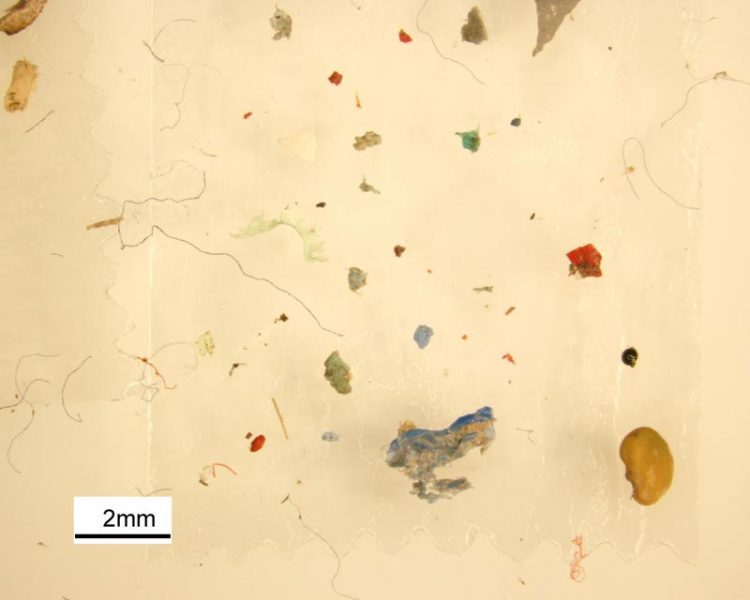Microplastics in the Great Lakes: Becoming benthic

Microplastics analyzed from nearshore and offshore benthic sediment samples in lakes, benthic sediment samples in rivers, and water samples in lakes and rivers. Image courtesy Patricia Corcoran
From the Great Pacific garbage patch to inland rivers, plastics are among the most widespread contaminants on Earth. Microplastics — particles of plastic smaller than five millimeters — are especially pervasive. As they build up in Earth's waters, microplastics are also becoming a permanent part of the planet's sedimentary layers.
Now, using the Great Lakes as a laboratory, sedimentary petrologist Patricia Corcoran and her students at the University of Western Ontario are studying the behavior of microplastics as a geologic phenomenon.
What are the main sources of microplastics to Great Lakes sediment? What factors influence their distribution, and where do they concentrate? To explore these questions, and shed light on implications such as which animals may be at risk from microplastics, Corcoran's team has analyzed offshore and nearshore sediment samples from Lakes Huron, Ontario, Erie, and St. Clair, and their tributaries.
Abundances were as high as 4270 microplastics particles per kilogram of dry weight sediment in lake sediment, and up to 2444 microplastic particles per kilogram in river sediment.
The team found that the more organic debris in the sample, the more microplastics. Benthic microplastics — those incorporated into lake bottom sediments — were also more abundant near high population areas, which are also associated with plastics industry locations.
Surprisingly, not all plastic fibers found in benthic samples were plastic after all. “When we chemically analyzed fibers only 33% were plastic. The others materials like dyed cotton or cellulose,” Corcoran says. “So we can't assume that every fiber we see under the microscope is plastic.”
Corcoran's team also sampled pellets (microplastics about the size of a lentil) from 66 beaches across all five Great Lakes. They found a total of 12, 974 pellets over 660 square meters of beach, about equivalent to an eighth the area of an American football field.
Except for the two beaches containing the most pellets, they found little relationship between population density or industry and number of pellets, says Corcoran. Instead, pellets were most concentrated near tributaries. “In other words,” she says, “rivers and creeks are the main pathways used by pellets to reach the lakes.”
Burial of microplastics in lake and river sediment is just one way Corcoran has explored how plastics are becoming part of Earth's future rock record. She's also investigated anthropogenic stones on a Hawaiian beach, which she and colleagues called “plastiglomerate.”
The Great Lakes study will be presented by Sara Belontz of the University of Western Ontario, on Tuesday, 24 Sept., at 2:30 p.m., in Room 224A, North Building of the Phoenix Convention Center. Paper 227-5: Anthropogenic Grains: Microplastics in Benthic Compartments of the Great Lakes Watershed https:/
###
Contact: Dr. Patricia Corcoran
Associate Professor and Department Chair
Department of Earth Sciences
University of Western Ontario
London, ON, Canada N6A 5B7
The Geological Society of America, founded in 1888, is a scientific society with 22,000 members from academia, government, and industry in more than 100 countries. Through its meetings, publications, and programs, GSA enhances the professional growth of its members and promotes the geosciences in the service of humankind. Headquartered in Boulder, Colorado, GSA encourages cooperative research among earth, life, planetary, and social scientists, fosters public dialogue on geoscience issues, and supports all levels of earth-science education.
Media Contact
More Information:
https://www.geosociety.org/GSA/News/pr/2019/19-40.aspxAll latest news from the category: Ecology, The Environment and Conservation
This complex theme deals primarily with interactions between organisms and the environmental factors that impact them, but to a greater extent between individual inanimate environmental factors.
innovations-report offers informative reports and articles on topics such as climate protection, landscape conservation, ecological systems, wildlife and nature parks and ecosystem efficiency and balance.
Newest articles
Humans vs Machines—Who’s Better at Recognizing Speech?
Are humans or machines better at recognizing speech? A new study shows that in noisy conditions, current automatic speech recognition (ASR) systems achieve remarkable accuracy and sometimes even surpass human…

Not Lost in Translation: AI Increases Sign Language Recognition Accuracy
Additional data can help differentiate subtle gestures, hand positions, facial expressions The Complexity of Sign Languages Sign languages have been developed by nations around the world to fit the local…

Breaking the Ice: Glacier Melting Alters Arctic Fjord Ecosystems
The regions of the Arctic are particularly vulnerable to climate change. However, there is a lack of comprehensive scientific information about the environmental changes there. Researchers from the Helmholtz Center…



